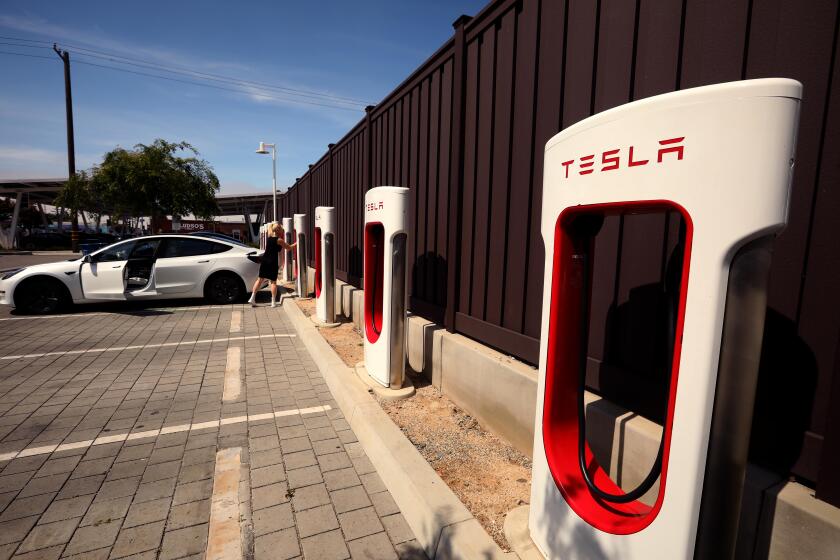Does it take AA or AAA batteries?
Hybrid gas-electric vehicles have been around for more than six years, yet many people still don’t understand how they work. Do you have to plug them in? Will they run out of electricity?
The Camry’s system provides a useful primer to the intricacies of hybrid technology.
Not all hybrids are created equal. Toyota’s uses a so-called “full-hybrid” system, in which the vehicle can move at low speeds on the strength of its electric motor alone, like a golf cart. Most hybrids on the market, or coming to the market, are full-hybrid designs. “Weak” hybrid systems (something of a misnomer) involve an electric motor sandwiched between the engine and transmission that only boosts power from the gas engine. Weak hybrid systems, such as that in the Honda Insight, don’t propel the vehicle on its electricity alone. In the case of GM’s hybrid pickups, the electric motor doesn’t add any propulsion but works as an oversized starter/generator, allowing the gas engine to switch off and on smoothly while coasting or stopped in traffic. All hybrids take advantage of this stop-start efficiency, which is one of the reasons they get better gas mileage in city driving.
The key to understanding hybrids is the fact that a motor and a generator are essentially the same device. When current from a battery is sent to an electric motor, the device spins an output shaft that can be used to propel the vehicle. When the output shaft spins, the device generates electricity that can be used to re-charge the battery. In this way, hybrids recapture kinetic energy otherwise lost in coasting and braking, a process called regenerative braking.
Like conventional cars, the Camry Hybrid has a gasoline motor: a 2.4-liter, Atkinson-cycle engine. This engine differs from a conventional Otto-cycle engine in that the expansion cycle -- when the ignited fuel gases expand in the combustion chamber, driving the piston that rotates the crankshaft -- is of longer duration than the compression cycle. This sacrifices some power for higher efficiency. The output of the gas-engine component of the Camry is 147 horsepower, or 110 kilowatts.
Full hybrids like the Camry Hybrid have two motor/generators aboard. The first acts primarily as a starter/generator, powerful enough to instantly restart the gas engine. The second motor is responsible for moving the vehicle.
At the heart of the hybrid system is a continuously variable transmission -- a CVT in car-ad-speak -- with two planetary gear sets that manage the give-and-take among the front wheels, the electric motors and the gas engine. These fluidly orchestrate the power flow so that, when the vehicle is accelerating, the electric motor and gas engine pull together; while coasting, the gas engine shuts off and the rotational power of the front axles drives the motor/generator to recharge the batteries and slow the vehicle.
For the most part, the driver is unaware of the dance of electrical and mechanical forces going on in the powertrain. The Camry Hybrid drives like a regular car, except at slow speeds when it moves silently on electrical power.
There are lots of complicated pieces here, including the voltage inverter, located under the hood next to the engine. This device converts high-voltage direct-current power (DC) to alternating current (AC) that the electric motors consume. Then there’s the hybrid control module, the computer that makes everything work together.
But the component regarded with the most suspicion is the battery -- in this case, a battery assembly made up of 34 nickel metal hydride modules (7.2 volts), for a total of 244 volts.
As anyone who has had a cordless phone die on them knows, batteries are not forever. The difference between batteries in consumer electronics and hybrid batteries is in their duty cycles. To preserve battery life, hybrid systems typically demand very little of them, using only a fraction of their capacity.
Toyota engineers expect these lightly stressed hybrid batteries in their cars to last the life of the vehicle. To date, few if any of the batteries have been replaced. Honda, the other major player in hybrids, has seen similar longevity in its hybrid batteries.
The national warranty on the Camry’s hybrid components is eight years or 100,000 miles, except in California and a few Northeastern states, where the warranty is 15 years/150,000 miles. The exception is the battery, which is warranted in California for 10 years and 100,000 miles.
*
(BEGIN TEXT OF INFOBOX)
Going hybrid? The options grow
Here are some of the other hybrid passenger models on the market. Prices are starting MSRP and do not include taxes and other fees. Annual mileage costs based on 15,000 miles a year, at a price of $2.34 a gallon. Note that unlike conventional vehicles, some hybrids get better mileage in the city than on the highway.
*
Toyota Highlander
Mid-size SUV
$33,030
33 city, 28 highway
Annual fuel cost: $1,169
*
Honda Accord
Mid-size sedan
$30,990
29 city, 37 highway
Annual fuel cost: n/a
*
Lexus RX 400h
Mid-size SUV
$45,355
33 city, 28 highway
Annual fuel cost: $1,169
*
Ford Escape
Compact SUV
$27,515
36 city, 31 highway
Annual fuel cost: $1,064
*
Mercury Mariner
Compact SUV
$29,840
33 city, 29 highway
Annual fuel cost: $1,134
*
Chevy Silverado
Full-size pickup
$27,985
18 city, 21 highway
Annual fuel cost: $1,846
*
Honda Insight
Compact coupe
$19,330
MPG: 57 city, 56 highway
Annual fuel cost: $628
*
Honda Civic
Compact sedan
$21,850
49 city, 51 highway
Annual fuel cost: $702
*
Toyota Prius
Compact sedan
$21,725
60 city, 51 highway
Annual fuel cost: $639
*
Sources: Edmunds.com, www.fueleconomy.gov, Times staff research



